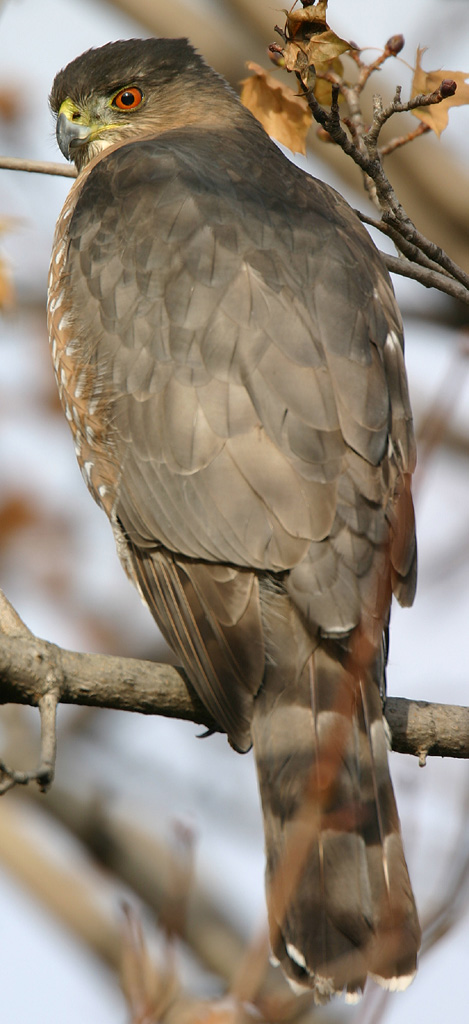Facts About Cooper's hawk
The Cooper's hawk is a captivating medium-sized bird of prey native to North America, ranging from southern Canada to northern Mexico. These agile hawks, members of the genus *Accipiter*, are known for their affinity for wooded areas. Notably, male Cooper's hawks are smaller than females, and those found east of the Mississippi River tend to be larger than their western counterparts. Often confused with the smaller Sharp-shinned hawk, they were named in 1828 by Charles Lucien Bonaparte in honor of William Cooper. These hawks, also referred to as big blue darters, chicken hawks, and swift hawks, are renowned for their hunting prowess. Their diet primarily consists of small-to-medium birds, small mammals, and occasionally reptiles. They prefer nesting in tall trees with dense canopies, typically raising two to four fledglings depending on environmental conditions. Despite facing significant challenges from pesticides and pollution in the 20th century, their population remains stable today.
In terms of appearance, Cooper's hawks have moderate-length wings, long tails, and strong legs and toes. Adult hawks exhibit blue-gray or brown-gray feathers on their upper parts, with blackish-brown crowns and streaked rufous cheeks. Their tails feature a blue-gray upper side, a pale underside, three black bands, and a distinctive white tip. Juveniles are dark brown with rufous edges and whitish mottling. Females are noticeably larger than males. These hawks produce a range of calls, with males emitting higher-pitched, faster-paced sounds. Although they are often mistaken for the Sharp-shinned hawk and Northern Goshawk, differences in size, plumage, and proportions distinguish them.
First described in 1828 by Charles Lucien Bonaparte, Cooper's hawks are part of the diverse genus *Accipiter*, comprising nearly 50 species. No subspecies of Cooper's hawks are recognized, although genetic markers indicate differences between western and midwestern populations. They are closely related to species like the Bicolored Hawk and Chilean Hawk. Their range covers southern Canada to northern Mexico, with variations in breeding and wintering habits. These hawks thrive in temperate deciduous and mixed forests, forested mountains, and even urban areas, demonstrating remarkable adaptability to fragmented habitats.
Behaviorally, Cooper's hawks exhibit typical *Accipiter* characteristics, being most active in the morning. They roost in conifers, preen frequently, and drink from secluded water sources. Juveniles display a behavior called proning, and all ages possess strong flight muscles that enhance their hunting capabilities. During the breeding season, they exhibit aggressive behavior and are often mobbed by other birds. Northern populations are more migratory, with migration periods from late August to mid-October and February to May. Juveniles generally migrate first, favoring mountain ridges and coastlines.
Cooper's hawks are bold hunters, primarily targeting small-to-medium birds, small mammals, and reptiles. Despite a reputation for hunting game birds like quail, their impact on these populations is minimal compared to human activities. They hunt with agile, twisting flights, often perching and scanning before making a swift attack. Occasionally, they hunt in pairs or even pursue prey on foot. Their prey includes a wide variety of birds, notably passerines, corvids, and icterids, as well as columbids, woodpeckers, and occasionally galliforms, mammals, and reptiles. Their powerful talons and high-speed foot strikes enable them to take down larger prey.
Regarding breeding, Cooper's hawks are generally monogamous but may engage in extra-pair couplings. They build large platform nests in tall trees, often reusing them for several years. Egg-laying varies by region, with clutch sizes averaging three to five eggs. The female primarily handles incubation, which lasts 34-36 days. The young hatch at different times, and the female broods them until they are about two weeks old. Fledging occurs at 27-34 days, and the young become independent around eight weeks. Juvenile dispersal distances vary, with females typically traveling farther than males.
Cooper's hawks can live up to 20 years, though their average lifespan is shorter due to high juvenile mortality. They face threats from predators such as great horned owls and raccoons, as well as collisions with manmade objects. They are also susceptible to diseases like West Nile virus and Trichomoniasis, particularly in urban areas. Historically, Cooper's hawks suffered severe declines due to persecution and DDT use, but their populations have rebounded since the 1980s. Today, there are around 800,000 Cooper's hawks in the United States and Canada, with stable or increasing populations in many regions.
Despite their adaptability, Cooper's hawks still face challenges from pollutants, collisions, and habitat loss. Urban environments offer both benefits and risks, providing abundant prey but also increasing the chances of collisions and disease. Conservation efforts focus on protecting nesting habitats and mitigating urban threats. While they occasionally prey on conservation-dependent species, their impact is generally minimal compared to human activities.

 Guatemala
Guatemala